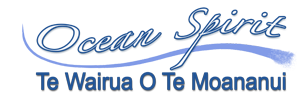
Hauora Moana Community Based Monitoring
The Hauora Moana (Healthy Ocean) Community Monitoring Initiative’s aim is to train local community members in a qualitative monitoring method that has been specifically developed for communities to use. The aim of the initiative is to support mana whenua and local community efforts in restoring the mauri – essential essence, life-force (Harmsworth & Awatere, 2013) – of local marine ecosystems. It is mana whenua who carry the inter-generational responsibility of kaitiakitanga (guardianship derived and bestowed through whakapapa) to maintain the physical and spiritual integrity of their ancestral rohe moana and ensure the ongoing health and wellbeing of both people and place. Pākehā and other Tau iwi (non-Māori who call Aotearoa home) can support this kaitiakitanga, by ensuring their activities are in harmony with the integrity and health of the ecosystems we are all part of. As local communities we can work together towards this common goal of ensuring a vibrant, healthy and life-sustaining moana for the generations to come.
This method can provide “real-time” feedback about the health and wellbeing of specific sites that are important to us, which can then inform responsive and appropriate management actions. The Hauora Moana Initiative is based on a qualitative reef survey methodology developed in Vanuatu and the Solomon Islands. The qualitative approach of this monitoring method is well suited for communities who want to assess the overall health of their marine ecosystems but can also be used to provide a qualitative assessment of locally important individual species. The method can also be used in conjunction with more quantitative monitoring of specific species when greater detail, such as population density and size ranges, are required. The methodology is the outcome of post-graduate research that investigated the level of correlation between traditional ecological knowledge and modern scientific ecological understanding. We want to facilitate and empower communities to take the lead in monitoring, understanding and caring for their local marine ecosystems.
View the Hauora Moana Monitoring Guidelines HERE.
There are three parts to the Hauora Moana monitoring programme: the survey, the consensus process and finally, analysis of the results.
Conducting the Survey
Although at first glance reefs all look similar to each other, there are many factors that make each reef slightly different, such as exposure to wind and waves, current patterns, proximity to river mouths, water quality, shoreline and underwater geography, and many other factors. All of these factors influence the reef and determine its natural, or normal state, including what types and how much seaweed and kelp will grow and the populations of fish and invertebrate species that will live there. All of these factors give every reef its own particular qualities, the things that make it different and unique from other reefs.
The most important difference between this and other reef monitoring surveys is that with this approach we are more focused on using our intuitive skills to tune in to the reef’s individual qualities so that we can better understand what is normal and natural for a particular reef and how healthy it is. Rather than counting or measuring, we are trying to get a sense or feeling for the overall wellbeing of the reef. Tuning into the reef’s individual qualities might sound hard, but the more familiar we become with our reefs the easier this becomes. To help us do this we will use a range of health indicators, including overall abundance and diversity, some important fish species, as well as potential impacts, such as nutrient indicator algae cover, kina barrens and sedimentation.
The Consensus Process
A key part of this monitoring approach is the use of a consensus process. By having several monitors surveying the reef, then comparing their results, there is less chance of individual bias affecting the accuracy of the survey. Ideally there should be a minimum of four monitors per survey. Reaching consensus simply means everybody agreeing about the current state of the reef. To reach consensus it is critical that all the monitors who conducted the survey have a chance to explain the reasons for where they marked each health indicator on their slate. There are no right or wrong answers; each monitor’s results provide important insights into the current state of health of the survey area.
Analysis
Analysis of the survey results is a simple process of transcribing the consensus outcomes onto a graph that places the result for each indicator on a health index scale. This scale relates directly to management responses, pre-determined by the community. The final results can then be reported back to the community.
Contact Us
Te Wairua O Te Moananui-Ocean Spirit Charitable Trust
- 150 Matapouri Rd, RD3 Whangarei, New Zealand.
- admin@oceanspirit.org
- +64 21 2772989

